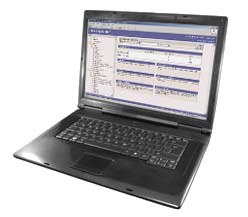|
Wyse X90L and X90Le
Thin client notebooks with wide screens
(by Kirk Linsky)
As safety in computing becomes ever more important, "thin clients" are become more and more attractive. A thin client, essentially, is a computer without local storage. It doesn't have a hard disk and operates as a smart terminal that can access host computers. The user runs terminal sessions that look like the real thing over either a wireless or wired connection. Thin clients usually have Smart Card readers for access security. So even if someone steals the device, the data is safe as it does not reside on the thin client. And without the Smart Card and password (and often other security measures), no host sessions can be stablished.

Wyse has been a leader in thin computing for many years. The company offers several types of devices, all providing "desktop virtualization solutions" such as Citrix Presentation Server and Citrix XenDesktop, VMware Virtual Desktop Infrastructure and Microsoft Windows Terminal Server environments as well as get access to existing back-end infrastructure using the Ericom - PowerTerm Terminal Emulation. As far as the actual OS goes, thin clients can run a variety of platforms. Wyse has its own Thin OS, but thin clients can also run Windows CE, Wyse Linux, and Windows XP Embedded. However, in each case, the actual applications are run on the host/server, and not on the thin client. However, each OS platform has different features and capabilities. In general, The Wyse ThinOS is leanest and XP Embedded largest and most powerful.
While many thin clients are small boxes with external keyboards and displays, Wyse also offers mobile systems that look exactly like standard notebooks. And on January 28, 2008, Wyse announced at the Citrix Solutions Summit in Orlando that it has complemented its existing X90/X90e thin client notebook with the new X90L and X90Le models (see picture above).
The X90L models are based on the VIA C7-M processor. Wyse chose the Ultra Low Voltage Model 772 version that runs at 1.2GHz and has lower power consumption than competitive processors. Since the X90L are meant to be desktop replacements and capable of display-oriented applications, they have 15.4-inch WXGA (1280 x 800 pixel) LCDs and run Windows XP Embedded. Compared to the standard X90 line that has 12.1-inch displays, the new models also have gigabit Ethernet, an SD Card slot in addition to the Smart Card reader, Bluetooth 2.0, multimedia support, and both VGA and DVI video output. There are no moving parts, which makes for extra reliability. There is also no fan which makes for quiet operation. The primary difference between the X90L and the X90Le models is that the X90Le has Bluetooth 2.0 and Smart Card security.
Despite the large display and the X90L weighs just over five pounds with the battery installed. With this model, Wyse added a mobile thin client that offers maximum speed when connected via its Gigabit Ethernet port, a large viewing area and multimedia capability, and flexibility while on the road via 3G or Bluetooth/cellphone connection to data networks.
-- Kirk Linsky
|



